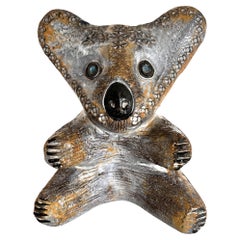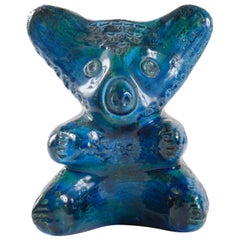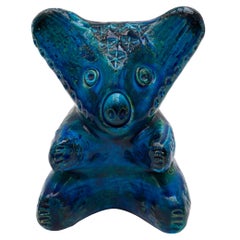Bitossi Koala
Vintage 1960s Italian Mid-Century Modern Ceramics
Ceramic, Pottery
Recent Sales
Vintage 1960s Italian Mid-Century Modern Pottery
Pottery
Vintage 1960s Italian Mid-Century Modern Animal Sculptures
Ceramic
People Also Browsed
21st Century and Contemporary Italian Modern Tableware
Quartz
21st Century and Contemporary Italian Organic Modern Chandeliers and Pen...
Brass
21st Century and Contemporary Italian Mid-Century Modern Barware
Murano Glass
21st Century and Contemporary European Chandeliers and Pendants
Brass
Antique Early 19th Century European Country More Dining and Entertaining
Pottery
Mid-20th Century Danish Scandinavian Modern Table Lamps
Copper
21st Century and Contemporary Italian Modern Tableware
Quartz
21st Century and Contemporary Indian Serving Pieces
Granite, Brass, Nickel
Mid-20th Century Japanese Mid-Century Modern Vases
Ceramic
Vintage 1920s French Art Deco Vases
Art Glass
Vintage 1970s French Mid-Century Modern Table Lamps
Ceramic
Vintage 1930s Italian Console Tables
Bentwood
Vintage 1960s Italian Coffee and Cocktail Tables
Wood
Vintage 1950s French Modern Wall Lights and Sconces
Bronze
Mid-20th Century American Mid-Century Modern Candlesticks
Chrome
Vintage 1970s American Space Age Tables
Chrome
Aldo Londi for sale on 1stDibs
Master Italian ceramist Aldo Londi created a range of decorative objects in the latter half of the 20th century for the manufacturer Bitossi. In addition to the small-scale animal sculptures for which he is best known, Londi designed a variety of ceramics for the famed company that includes vases, bowls and desk accessories. Collectors know that vintage Aldo Londi pottery is marked by deep attention to detail and an integration of rich, alluring hues typically associated with the Mediterranean.
Londi was born in Montelupo Fiorentino, just outside of Florence, an area that has been known for its pottery since the Renaissance. Londi showed an early interest in the craft, apprenticing at the Fratelli Fanciullacci ceramic workshop when he was only 11 years old. He worked at the company until he left to fight in World War II. After returning to Montelupo Fiorentino in 1946, Londi became the creative director at Bitossi — a position he held for more than 50 years.
Londi's fresh and unique style breathed new life into Bitossi. He prioritized the production of high-quality and handmade decorative objects and created many of Bitossi's pottery lines himself. The most famous of Londi's Bitossi collections is the Rimini Blu line of animals and vases, which debuted in 1955. The collection is characterized by geometric and whimsical patterns and is recognizable for its marvelous blue color.
Londi's fame and popularity extended outside of Italy with the help of Raymor. The American import and distribution company introduced many esteemed Italian manufacturers such as Bitossi to boutiques and department stores in the United States. After Raymor founder Irving Richards hired Ettore Sottsass to design ceramics, Richards connected his new recruit to Londi. Decades before he founded a legendary postmodern design collective in Milan called the Memphis Group, Sottsass used the Bitossi kilns to create timeless works that manifest both primitive forms and modern geometries.
In 2021, Bitossi opened the Bitossi Archive Museum at its Montelupo Fiorentino headquarters. Many of the works designed by the company's most esteemed contributor and artistic director, Aldo Londi, are proudly displayed.
On 1stDibs, find vintage Aldo Londi serveware, lighting, decorative objects and more.
A Close Look at Mid-century-modern Furniture
Organically shaped, clean-lined and elegantly simple are three terms that well describe vintage mid-century modern furniture. The style, which emerged primarily in the years following World War II, is characterized by pieces that were conceived and made in an energetic, optimistic spirit by creators who believed that good design was an essential part of good living.
ORIGINS OF MID-CENTURY MODERN FURNITURE DESIGN
- Emerged during the mid-20th century
- Informed by European modernism, Bauhaus, International style, Scandinavian modernism and Frank Lloyd Wright’s architecture
- A heyday of innovation in postwar America
- Experimentation with new ideas, new materials and new forms flourished in Scandinavia, Italy, the former Czechoslovakia and elsewhere in Europe
CHARACTERISTICS OF MID-CENTURY MODERN FURNITURE DESIGN
- Simplicity, organic forms, clean lines
- A blend of neutral and bold Pop art colors
- Use of natural and man-made materials — alluring woods such as teak, rosewood and oak; steel, fiberglass and molded plywood
- Light-filled spaces with colorful upholstery
- Glass walls and an emphasis on the outdoors
- Promotion of functionality
MID-CENTURY MODERN FURNITURE DESIGNERS TO KNOW
- Charles and Ray Eames
- Eero Saarinen
- Milo Baughman
- Florence Knoll
- Harry Bertoia
- Isamu Noguchi
- George Nelson
- Danish modernists Hans Wegner and Arne Jacobsen, whose emphasis on natural materials and craftsmanship influenced American designers and vice versa
ICONIC MID-CENTURY MODERN FURNITURE DESIGNS
- Eames lounge chair
- Nelson daybed
- Florence Knoll sofa
- Egg chair
- Womb chair
- Noguchi coffee table
- Barcelona chair
VINTAGE MID-CENTURY MODERN FURNITURE ON 1STDIBS
The mid-century modern era saw leagues of postwar American architects and designers animated by new ideas and new technology. The lean, functionalist International-style architecture of Le Corbusier and Bauhaus eminences Ludwig Mies van der Rohe and Walter Gropius had been promoted in the United States during the 1930s by Philip Johnson and others. New building techniques, such as “post-and-beam” construction, allowed the International-style schemes to be realized on a small scale in open-plan houses with long walls of glass.
Materials developed for wartime use became available for domestic goods and were incorporated into mid-century modern furniture designs. Charles and Ray Eames and Eero Saarinen, who had experimented extensively with molded plywood, eagerly embraced fiberglass for pieces such as the La Chaise and the Womb chair, respectively.
Architect, writer and designer George Nelson created with his team shades for the Bubble lamp using a new translucent polymer skin and, as design director at Herman Miller, recruited the Eameses, Alexander Girard and others for projects at the legendary Michigan furniture manufacturer.
Harry Bertoia and Isamu Noguchi devised chairs and tables built of wire mesh and wire struts. Materials were repurposed too: The Danish-born designer Jens Risom created a line of chairs using surplus parachute straps for webbed seats and backrests.
The Risom lounge chair was among the first pieces of furniture commissioned and produced by celebrated manufacturer Knoll, a chief influencer in the rise of modern design in the United States, thanks to the work of Florence Knoll, the pioneering architect and designer who made the firm a leader in its field. The seating that Knoll created for office spaces — as well as pieces designed by Florence initially for commercial clients — soon became desirable for the home.
As the demand for casual, uncluttered furnishings grew, more mid-century furniture designers caught the spirit.
Classically oriented creators such as Edward Wormley, house designer for Dunbar Inc., offered such pieces as the sinuous Listen to Me chaise; the British expatriate T.H. Robsjohn-Gibbings switched gears, creating items such as the tiered, biomorphic Mesa table. There were Young Turks such as Paul McCobb, who designed holistic groups of sleek, blond wood furniture, and Milo Baughman, who espoused a West Coast aesthetic in minimalist teak dining tables and lushly upholstered chairs and sofas with angular steel frames.
Generations turn over, and mid-century modern remains arguably the most popular style going. As the collection of vintage mid-century modern chairs, dressers, coffee tables and other furniture for the living room, dining room, bedroom and elsewhere on 1stDibs demonstrates, this period saw one of the most delightful and dramatic flowerings of creativity in design history.


